After 14 years, Coworking Europe returned to Berlin this November with its best and biggest conference in its history. More than 500 operators, community builders, and industry leaders from over 50 countries came together. For two days, the conference center of the Hilton Berlin became a place for learning, honest conversations, and shared challenges. The sessions, which sometimes ran up to three in parallel, explored everything from security and AI to community metrics, design systems, flex market outlook, and the future role of independent operators.
This year, our cofounders Alex and Thilo attended the event.
The conference opened with the announcement of the C20 initiative, a joint project by GCUC and Coworking Europe aimed at strengthening collaboration between coworking networks worldwide. The goal is to challenge outdated narratives, highlight the real impact of coworking, and build unified voices across regions so the sector can shape its own story with shared values, real data, and a clear vision for the future of work.
1. Data and Market Insights Shaping Coworking in 2025
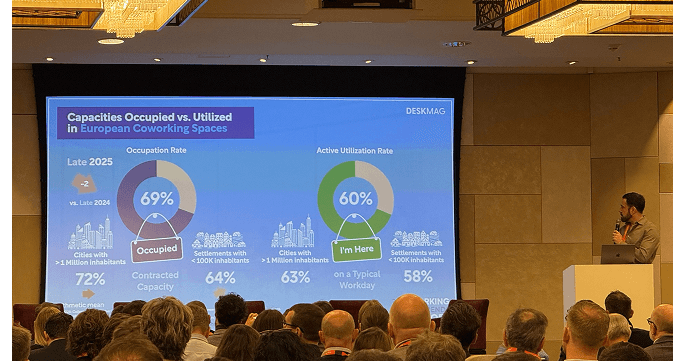
Right after the big opening announcement, Carsten Förtsch shared the numbers from Deskmag’s newest survey, followed later that day by a keynote from Joachim Gripp (Design Offices) and a panel discussion on the external forces affecting coworking. Together, these sessions offered a clear snapshot of how the sector is performing.
What the data shows
- Profitability continues to rise. Fifty-seven percent of spaces reported being profitable in late 2025.
- Contracted capacity sits at 69 percent across Europe, and daily active use is at 60 percent.
- Demand remains strongest for private offices, dedicated desks, hot desks, and events.
- AI use is growing. Most operators use it occasionally or for a few routines such as marketing, emails, and research.
- Staff productivity is the area where AI has the biggest impact.
The economic reality
Joachim Gripp’s keynote made one point clear. Coworking may be maturing, but it still sits inside a wider economic landscape that is shifting quickly. Many operators feel the effects of:
- A cooling economy with slower business
- Cautious clients and longer sales cycles
- Oversupply driven by short-term subleases
- Rising rents linked to inflation
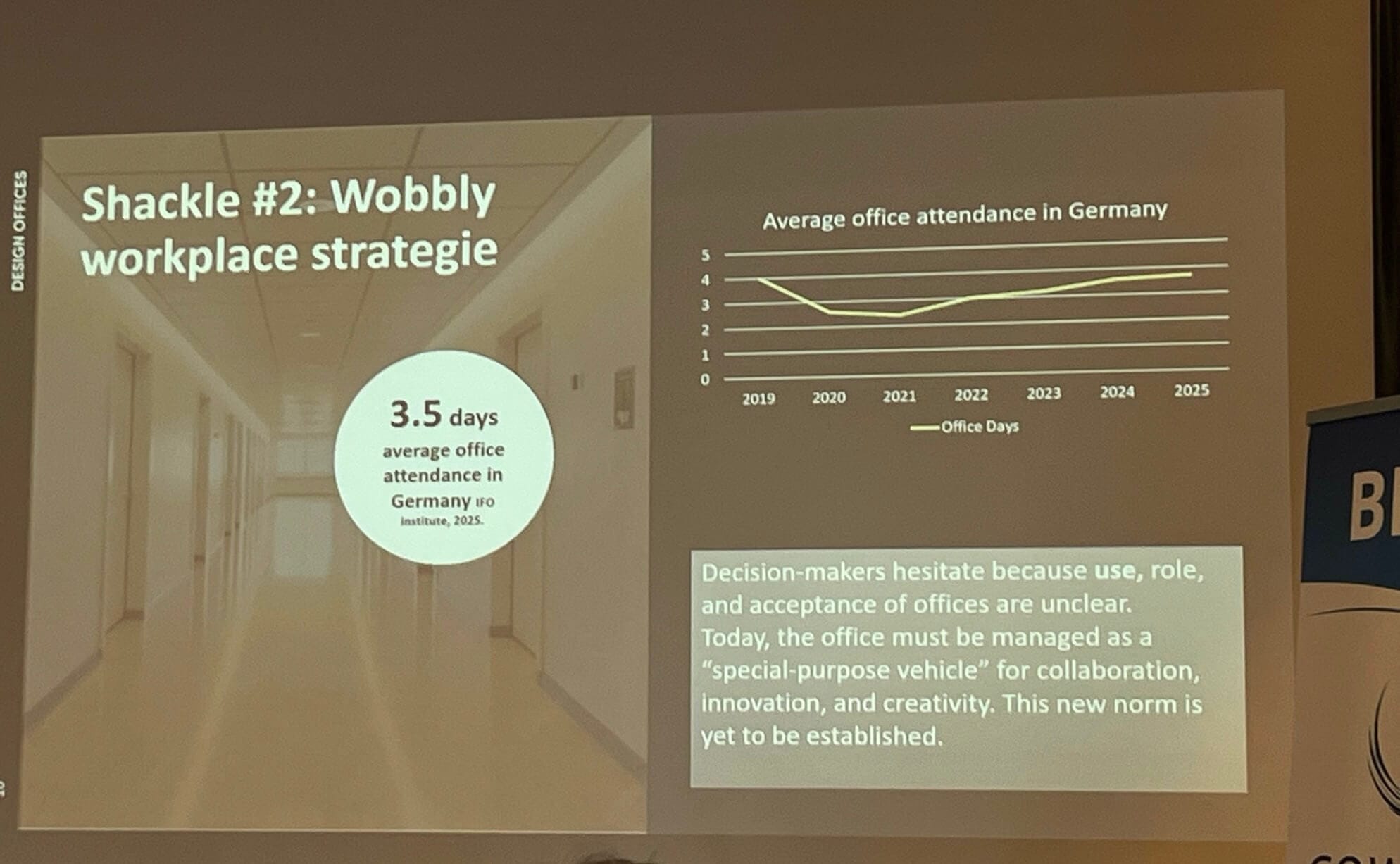
His slides added context. Subleases are creating temporary price pressure. Only prime office rents are rising while the average stagnates. Companies want smaller, high-quality spaces. Some forecasts suggest overall office demand could decline by up to 20 percent by 2030.
How operators can respond
Improve quality, support clients with data, keep pricing stable, and build a diverse customer base. In cities, prime location remains the key factor. Spaces that stay adaptable and grounded in value are in the strongest position to navigate the next few years.
2. Community and the Humans Behind Successful Spaces
Several sessions focused on the people side of coworking. Together, they created one clear message. Community is not an accessory. It is a strategic advantage that needs intention, systems, and care.
A structured way to measure community
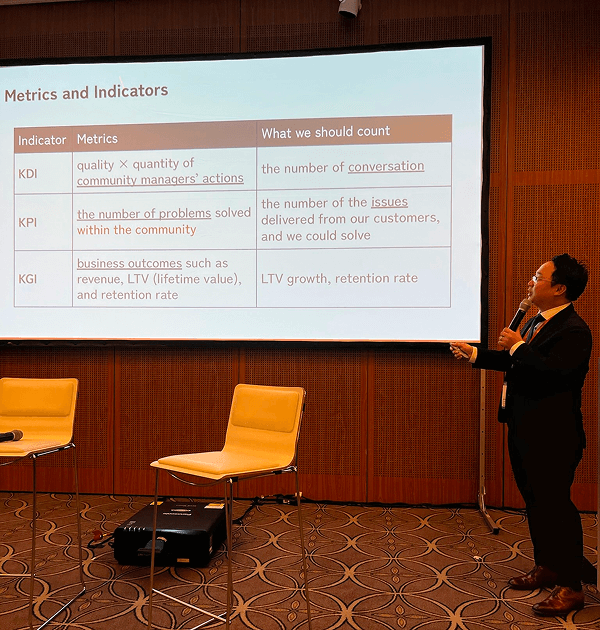
Yuta Aoki from the Japan Coworking Space and Community Manager Organization (JCCO) introduced a simple model to measure community work:
- KDI (Key Driver Indicators) tracks the daily actions of community managers.
- KPI (Key Performance Indicators) measures community impact through problems solved.
- KGI (Key Goal Indicators) connects community health to retention, revenue, and lifetime value.
This approach elevates community work to something measurable that can guide investment and leadership decisions. Practical challenges and effects were discussed in the following panel with Maudy Westerveld from EBC Amsterdam, Camila Caires of Avila Workspaces, and Teresa Garcia de Zuniga from Cloudworks.
Independent spaces proving the impact of care
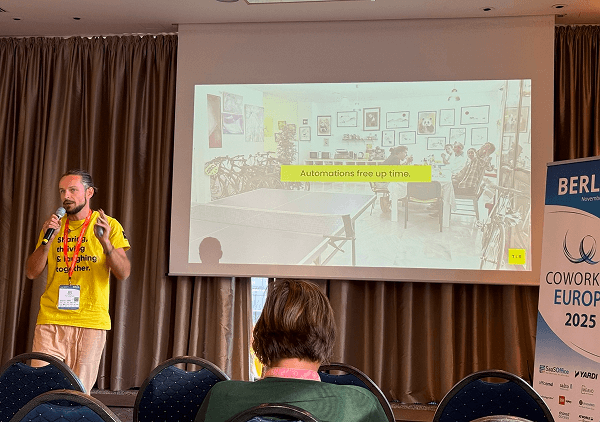
The Small and Happy session with Luca Dioda (Yoroom Milan) and Ben Kolp (The Living Room Malaga) showed how independent operators thrive in competitive markets.
The Living Room focuses on knowing every member personally, creating regular gathering moments, and building well-being initiatives such as yoga and nature outings. Ben highlighted how automation helps them to free time for real connection.
Yoroom keeps its edge by improving the space continuously, investing in thoughtful design, and consistently organizing community activities. Spending part of their income on owning part of the property offers them long-term stability.
Both spaces grow by staying true to their personality and treating care as a strategy.
Community as economic value
Pauline Roussel from Coworkies shared lessons from her new book Make Community Work, which is based on more than 100 interviews. The project focuses on the invisible layer of coworking that shapes how people feel in a space. Her insights showed that strong onboarding, emotional safety, and clear systems of care directly influence retention and advocacy.
Pauline explained that community is not a feeling. It is a system that needs structure, intention, and consistency. When members feel they belong, they stay longer, contribute more, and help spaces grow.
3. The Future of Workspaces: Adaptable, Social, and Circular
Sessions on design brought together insights from Robert Thiemann (FRAME) and Lukas Kauer (Panels by Knauf). They painted a picture of how workspaces are evolving.
Four design directions stood out
- Offices that can be reconfigured without construction
- Environments that support rest, movement, nutrition, and wellbeing
- Layouts that encourage natural encounters
- Circular systems built from modular, reusable parts
Lukas presented a wall system held together by friction rather than screws. It supports cabling, allows furniture to be hung without drilling.
The message was simple. Workspaces must evolve with people, not against them.
4. Technology, AI, and Smart Integration
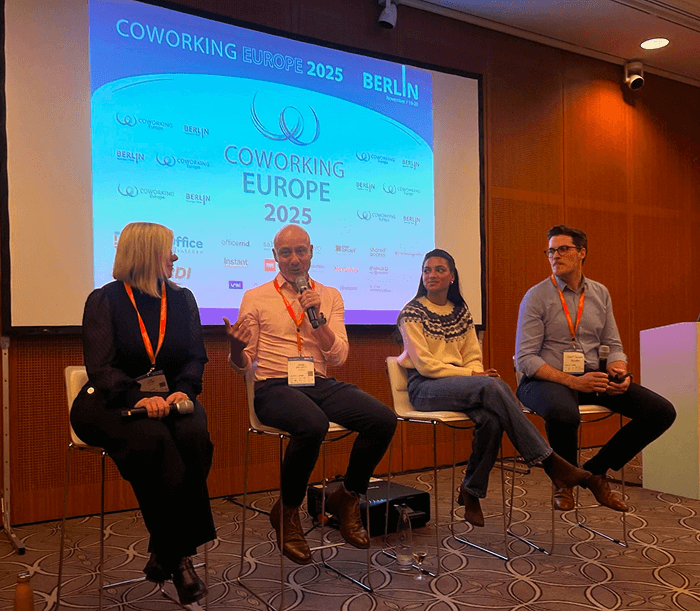
AI was a recurring topic this year, but the discussions stayed grounded. The panel with Kane Willmott (IQ Offices), Anika Coutinho (Uniti AI) and Rob Stevenson (Techspace) explored where AI helps and where it does not.
What actually works
- Use AI for specific workflows.
- Clean data before using it.
- Let AI support sales and member analysis, not replace teams.
- Train AI tools slowly and review their output.
- Keep people involved where nuance and empathy matter.
Examples included analyzing member lists, identifying patterns, and using AI for inbound sales conversations.
What to avoid
- Expecting AI to be a full solution
- Skipping training and iteration
- Overestimating cost savings
- Treating AI as a replacement instead of a tool
5. Security as a Core Part of Member Trust
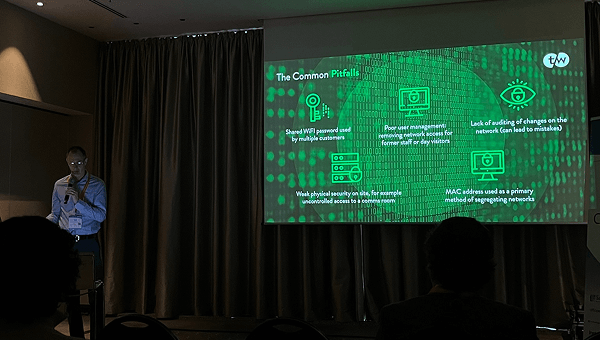
The session led by Adam Case (technologywithin) and insights from Thom Wernke (StartDock) made security feel less technical and more operational.
What puts spaces at risk
- Shared WiFi passwords
- Former members retaining access
- Weak physical protection
- Missing audit trails
- Network hardware that is no longer receiving security updates
What spaces can do today
- Use tools designed for flexible workspaces for an audit trail
- Work with a trusted security consultant
- Limit physical access to critical rooms
- Use enterprise authentication for your Wi-Fi, e.g., with RADIUS
- Keep hardware and software up-to-date
- Check that vendors follow proper certifications
An audience member shared that a buyer once ran secret security tests on one of their buildings before purchase to have an argument for lowering their offer. It showed how directly security affects trust and valuation.
A closing remark was that the trust of a secure space and network should never be an add-on, but built into your offering.
6. Ecosystem Building and New Revenue Models
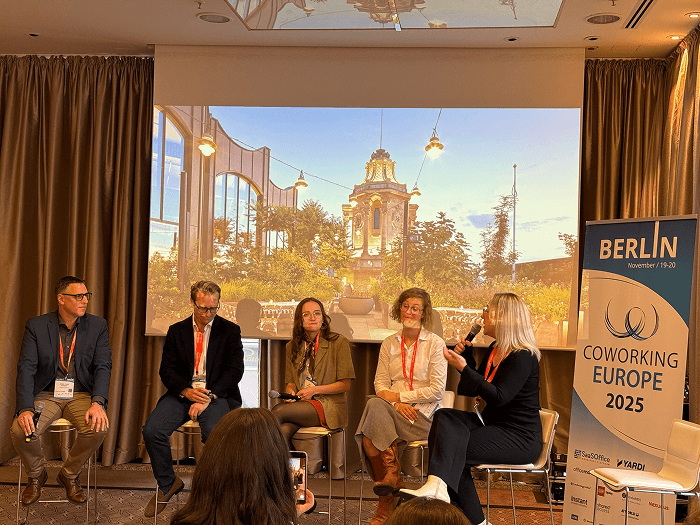
The keynote from Rupert Dean (X+Why) and the panel with Izzy Ahrbeck (Impact Hub Berlin), Laura Lüdecke (Ruby Workspaces) and Kat Dementyeva (CIC Berlin) showed how coworking spaces are expanding their role in local economies.
Examples from the session
- X + Why’s club spaces offer hospitality-focused memberships, dining, childcare, and curated events.
- CIC Berlin earns half its revenue from events.
- Some operators rent out specialized rooms, so-called wet labs, which are designed for experiments involving chemicals, water, or biological materials, to scientists.
- Impact Hub Berlin builds communities around specific industries, like circular construction.
- Hotels collaborate with coworking operators by opening events to wider audiences.
The shared takeaway? Leaning into the idea of coworking spaces as ecosystem builders can deepen impact and open new revenue streams.
7. Ethics and Fair Competition
A panel with Bruno Rebille (Synaphe), Claudius Krucker (Coworking Switzerland), Nir Kelner (Brain Embassy), Maudy Westerveld (EBC Amsterdam), and Sergi Tarragona (Cloudworks) addressed a growing problem in dense markets.
Operators shared stories about aggressive prospecting, competition showing up as “interested clients”, brokers prioritizing commission over trustworthy relationships, and branded vans parked outside competitors.
While spaces with strong communities are resilient to such tactics, they still annoy members and distract staff.
Many felt that national associations could lead the effort to create a shared code of conduct for operators to clearly discourage such tactics.
Trust and transparency strengthen the whole sector.
8. The Fuck-Up Session: Closing with a laugh
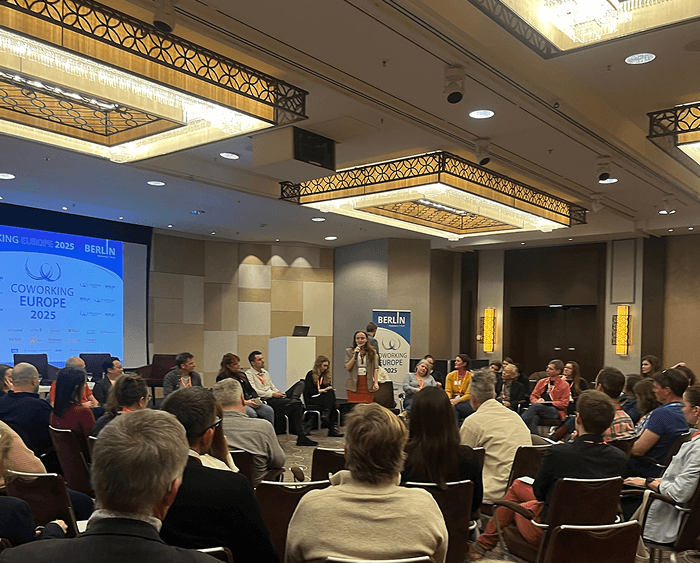
Moderated by coworking pioneers Claire Carpenter (Claire Carenter Coaching) and Julianne Becker (Coconat), the final session mixed humor with learning.
Stories included:
- A commissioned artwork that became very problematic because not every artwork is for public showing, no matter how beautiful.
- A pre-opening party turned into a super-spreader event with no one left to assemble the furniture. In the end, the community helped out.
- A very bitter coffee tasting by a non-coffee drinker. Not every trend is worth following.
- A spontaneous last night drink that set off a missing person hunt. Now the team communication has improved a lot.
It was a great closing format to level everyone on the fact that we make mistakes and learn from them. Afterward, the crowd dispersed into the Berlin night, many continuing the conversations over a self-organized dinner at the Kalle Halle Food Mall.
Closing Thoughts
Coworking Europe 2025 highlighted an industry that is growing more intentional, more data-informed, and more focused on care. Operators are navigating real pressures while building systems that support people, trust, and long-term resilience.
The conference, the dinners, and the surrounding tours offered plenty of opportunities to personally deepen the conversations across geographical, organizational, and professional boundaries on all the matters above and so grow the collective knowledge of our sector. We were grateful to spend time with the pioneers who helped shape coworking in its early days and with the new voices who are shaping what it becomes next.
And it has all been brought together beautifully thanks to the Coworking Europe team around Szilvia Filep, Robert Faulhaber, and Jean Yves Huwart. We are already excited about next year.
